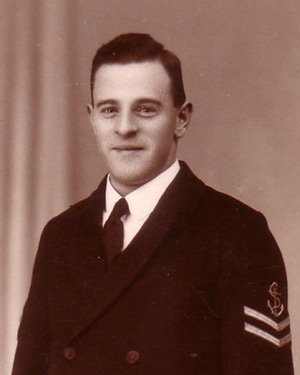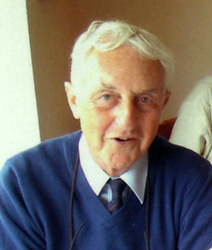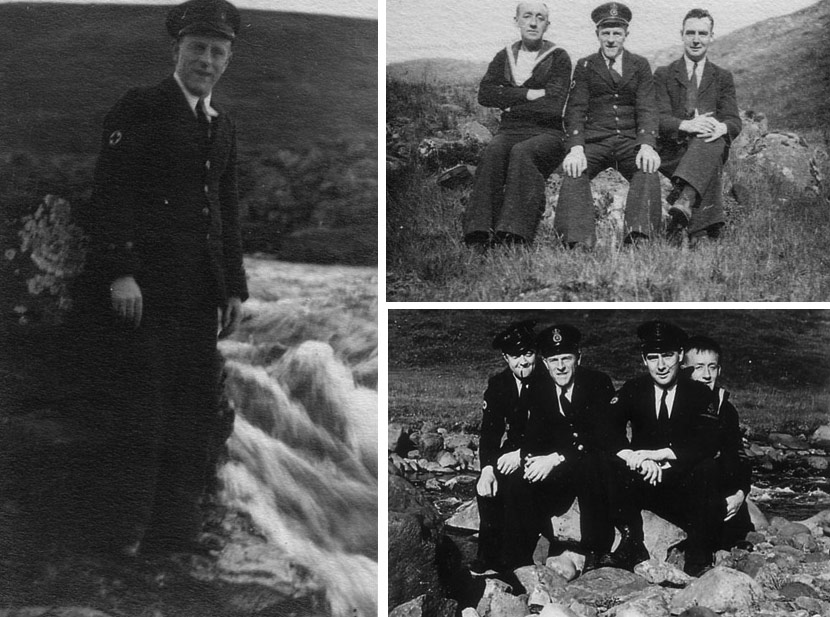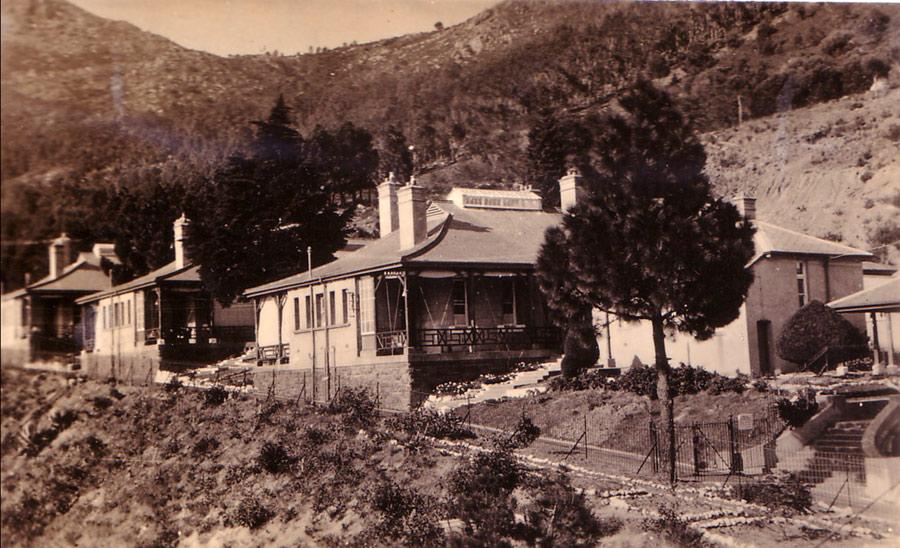







 Norman
Reeves Brown joined the Royal Navy in 1921 and spent very little time at home
with his wife and two sons. Kenneth Brown, the oldest son,was 13 when
his father died and describes below the father he lost when when Hecla was torpedoed. Kenneth Brown is on the left and his father on the right.
Norman
Reeves Brown joined the Royal Navy in 1921 and spent very little time at home
with his wife and two sons. Kenneth Brown, the oldest son,was 13 when
his father died and describes below the father he lost when when Hecla was torpedoed. Kenneth Brown is on the left and his father on the right.
"The
written accounts of the events of 11-12 November 1942 are mostly from
and about the survivors and so I think it appropriate to write what I
know of my father who lost his life on that night and who also deserves
a place in the recorded history of HMS Hecla.
My Dad was one of six children. He grew up in Liverpool where his
ex-Navy father was a Customs Officer, and joined the Navy at Devonport
on
the 13 May 1921. He
met his wife, Kathleen Trevillion, known as Nita, in Plymouth and they
married in 1927. They set up home at St Budeaux, within the city
boundary, and I arrived on the scene in July 1929 and my brother seven
years later. The studo photograph on the right was taken in 1931. During our childhood he spent two and a half years in
China and a similar period in the RN Hospital at Simonstown, South Africa.
He and mother wrote to each other daily and posted the missive once a
week. I think he quite enjoyed Simonstown and regularly took the train
to Cape Town and climbed Table Mountain. He returned to Britain on the Llandovery Castle and and was at the RN Hospital Stonehouse, Plymouth, in the late thirties but at the outbeak of war was at sea on
HMS Norfolk."
CPO Norman Brown joined Hecla at Greenock in 1940 in time for its commissioning and most of the photographs the family have of him were taken while Hecla was the destroyer depot ship for Atlantic escorts at Havelfjord in Iceland. Hecla
was a Devonport ship and most of the crew came from Plymouth and the
surrounding area. While they were safe and secure in Havelfjord their
families were living through the Plymouth Blitz and their children
being evacuated to neighbouring towns.

Three photographs of CPO Norman Brown ashore in Iceland with members of the Sick Bay team on HMS Hecla.
He is in the centre in the photograph on the upper right and second left in the photograph on the lower right
Courtesy of Kenneth Brown
HMS Hecla
retuurned to the Clyde early in 1942 for a short refit and then
headed south via the Cape to join the Far Eastern Fleet. After Hecla was badly damaged by a mine off Cape Agulhas on the 15 May 1942 it was guided into the harbour at Simon's Town by HMS Tug St Dogmael,
skippered by by Joss Margerrison. Norman had got to know the Margerrison family while stationed in Simonstown during the 1930s. He met Joss after they docked and
the story goes that they went to a pub somewhere, over celebrated and
Joss was in trouble for getting home late.
I knew about Dad's frienship with the Margerissons from his letters and have been to Capetown twice. When I revisited the Simon's Town Museum I was put in touch with Joss Margerisson's daughter, Audrey, who helped in the Museum. She told me that the crew of Hecla were so grateful for the hospitality received, that they threw a party for the locals at the Muizenberg Pavillion which was a very grand affair. Audrey was brought home from the convent school for the occasion and attended in specially purchased new shoes. I also found out that my Dad's 'Uphomer' was a Mrs Anne Hopwood who it turns out was Audrey's courtesy Aunty. Norman introduced Arthur Ching to the Margerissons during the five months Hecla was under repair in the naval dockyard and he described his memories of them and "Brownie" in a long letter to Mrs Margesson in 1979. There is so much around Capetown associated with memories of my Dad."
Audrey recalled that
"Norman Brown worked for the first two weeks in the operating theatre
on the ship with Surgeon Lt Cdr Hetherington trying to patch up
casualties and seeing them safely to the RN Hospital in Simon's Town".
This was the same hospital (below left) where he had been based in the
1930s, high on the hill above Simon's Town Harbour and accessed by
cable car from the shipyard.


Ken continues, "I did not have much time with my Dad and rely on information from family and most of all from his shipmates to get to know him. In particular to George Male who wrote this to me in December 1993:
'I
did try to convey to you the high esteem and affection we had for your
Father. Like Nelson he was a small man but we were left in no doubt
where authority lay – and that applied to the medical officers as well
– like me they were ”civvies” in for the duration. As you know service
life is strictly hierarchical and the Chief should have messed
separately. It is a measure of the man that Norman Brown was able to
live with his men 24 hours a day and still maintain his authority.'
Ken
knows very little about what happened to his father on the night of the 11 - 12 November when Hecla was torpedoed. Arthur Ching, a supernumary SBO, described what happened and recalled the last time he saw "Brownie":
'At 11 pm on the 11 November 1942 Hecla
was struck by the first of five torpedoes, in a boiler room beneath the
sick Bay where Brownie and I were sleeping, we immediately dressed and
got the sick patients to the wardroom ante-room, after this, two more
torpedoes struck the ship, which cut off power to the boat hoists. The
captain gave the orders to "abandon ship", which necessitated lowering
of all the rafts etc with no lights; there was bound to be some
confusion and I believe that some people were struck by falling
life-rafts and sustained fatal injuries. My last sight of Brownie was
in the wardroom prior to "abandon ship".'
George
Male described his final memory of "Brownie" before they abandoned ship:
"I
gather from other survivors that he made it to a Carley Float, hung on
as long as he could and then let go. He was a relatively old man of
forty with twenty one years service in the Royal Navy and the probability is that exhaustion overcame him and his body
would take no more. Who knows?
I missed the love, affection, guidance and company of a fine man who
gave of his best and earned the respect and affection of his peers. My
Mum had to go to work to bring up two boys, the war widows pension was
little, and she had a tough time. When I think of his short time at
home
with his family in comparison with the 54 years I have enjoyed with
mine, I realise how he was robbed."
Kenneth explained how the family fared after his father died: "Mother
did voluntary war work typing for an institution for the blind until
father was classified as presumed dead when, I imagine, she was paid as
a war widow and had to get paid employment to support herself and two
children. I was an evacuee living near St. Austell and attending Sutton
High School for Boys which was evacuated from Plymouth following the Blitz of April 1941. My
mother had to work from that time onwards until she was 65 years old in
1972. I was not much help as I was articled to an Accountant and earned
a pittance. My articles expired Feb 1951 and I was called up to do my
National Service and commissioned into the RAF Regiment. My brother
trained as a Quantity Surveyor before being called up for National
Service so was also unable to contribute to the family purse. Mother
devoted the rest of her life to raising the family, only giving up when
she died in 1989 when the family home in St Budeaux was finally sold. I
became an accountant in Helston, Cornwall, where I live today. By
reason of my efforts Dad had three granchildren and, by their efforts,
ten great grandchildren."